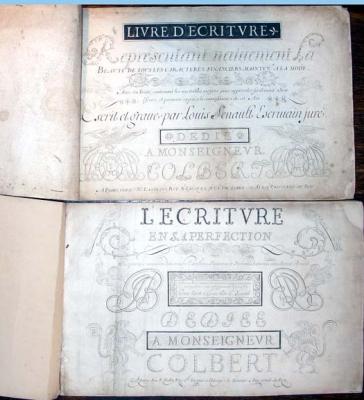In the seventeenth and eighteenth centuries, “writing masters” would produce manuals of perfect calligraphic script that students would copy over and over until they had a perfect hand of their own. Often the masters would try to out-do each other with elaborate flourishes and decorative elements added to the standard alphabet. The engravers who produced these manuals were superb technicians, able to cut even the most complex italic curves with equal amounts of flamboyance and grace.
The graphic arts collection is fortunate to have acquired two early writing books engraved by Louis Senault. We can see the date 1668 in one plate from the top volume and so, date it accordingly. Senault engraved approximately ten similar books between 1660 and 1693. None of the writing books published under his own name are dated, and, as David Becker remarks in his wonderful reference source, The Practice of Letters, their bibliography is further complicated “by both the apparent interchangeable use of engraved writing samples in different publications and the existence of different engraved versions of writing samples having deceptively similar texts.”
Each of these volumes includes a complete alphabet, along with decorative grotesques and animal figures. The second edition above gives particular emphasis to “Italian bastarde,” the hand used in French archival documents from the sixteenth to eighteenth centuries, notable for the characteristic wavy, free lines of the letters.
Senault is also noted for producing a fully engraved and very decorative book of hours, first published around 1680, and also available at Princeton University.

Compliments! it's not frequent that libraries realize that writing copy books are an important issue. I've a collection of my own and I'm also an historian of the subject (one of the very few): Senault is a very important name in the history of calligraphy. Do not hesitate to contact me if you have any question.
Francesco Ascoli
f.ascoli@alice.it
Compliments! it's not frequent that libraries realize that writing copy books are an important issue. I've a collection of my own and I'm also an historian of the subject (one of the very few): Senault is a very important name in the history of calligraphy. Do not hesitate to contact me if you have any question.
Francesco Ascoli
f.ascoli@alice.it
Aaaah. I wish you'd posted something from inside the book. There are only a few of his images online from a quick google image search. Some of his work calls to mind the Spanish master calligrapher from earlier in the 17th cent. - Pedro Diaz Morante